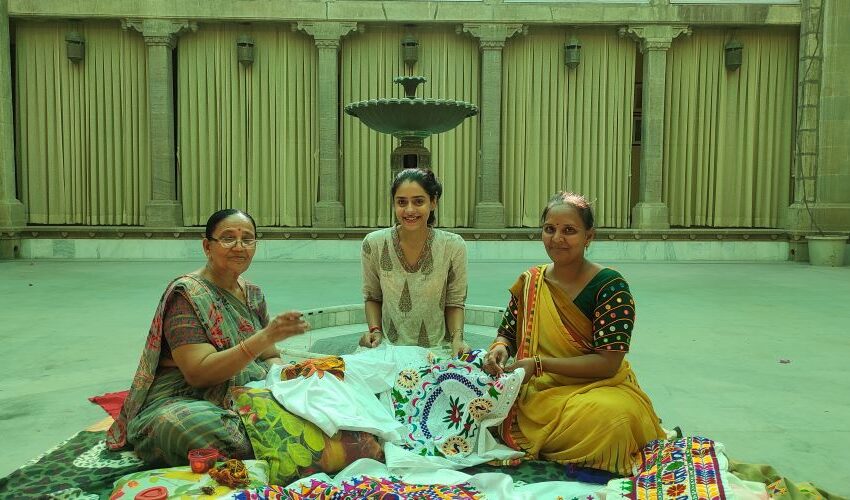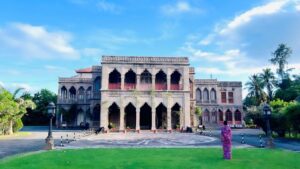‘Private-public partnership is crucial for promoting & sustaining heritage’

Brijeshwari Kumari Gohil with rural craftswomen
Rajkumari Sharma Tankha
Belonging to the royal family of Bhavnagar, heritage conservationist Brijeshwari Kumari Gohil, was passionate about anything and everything old be it buildings, art or crafts, or fashion since her childhood. That’s the reason, she moved to UK to pursue education in heritage conservation, when she found there was no scpe to do the same in India. Once done, she returned to her mother country to take up conservation projects here. She is presently involved in restoring Gandhi Smriti, an old museum that houses ancient textiles and local craft objects. She also undertakes Heritage Walks in the city so that people can get to know their city and develop a bond with it. Excerpts from a interview:
When and how did you get interested in heritage? How did you go about pursuing it?
Growing up in Bombay, I did not have a lot of exposure to my family’s heritage. But my summer and Diwali holidays would always be in Bhavnagar and my mother and grandmother worked hard to teach my brother and me about our family ancestry.
As my passion in the arts grew, I took a larger interest in culture and heritage. Comparing international historic sites to national sites while on holiday instilled in me a feeling of duty to want to contribute and tackle issues that were being faced in Indian cultural heritage sites and crafts. When the time to pursue my BA and MA came, I knew I wanted to study these subjects. Unfortunately, India did not have many options, especially at that point. So, I pursued my BA Joint Honours in Archaeology and History of Art from the University of Nottingham and MA in Heritage Management and Conservation from Durham University.
Conventionally, parents want their wards to take up set jobs (read becoming engineers, doctors, architects or get into a sarkari naukri)…
Fortunately, my mother is a lover of the arts and was always supportive about following ones passion and dreams. Thankfully, I did not face any challenge in this space. Hailing from a conservative background it was a big deal for me to go abroad to pursue my BA but I had a very solid support system.
Tell us more about Bhavnagar Heritage.
When I moved to Bhavnagar in 2017, I was looking for ways to occupy myself besides the family business and create my own identity here. My education, professional qualification and passion for heritage led me to start exploring my hometown – something I never did while growing up in Mumbai. Documenting historic sites and then learning about the crafts, art forms and the fact that many were not being maintained well, led me to start a society for the people by the people.

Once a home to the Gohil clan, Nilambagh Palace is now a heritage hotel
You are currently restoring an old museum that houses ancient textiles and local craft objects. Throw more light on the project please.
The Gandhi Smriti building is a heritage site in Bhavnagar. The structure houses one of the oldest libraries of Gujarat along with a photo gallery on Mahatma Gandhi. One floor was a dedicated craft museum but had been locked up for the past two decades! I had the museum opened and with the support and cooperation of the Trustees, applied for a grant to restore and redesign this space.
As Convenor for INTACH Bhavnagar, I was lucky to get help from the head office in Delhi. We started revamping the space, documenting the artefacts, archiving them and then restoring them. These include, beautiful textile pieces, ivory and wooden artefacts. Sadly, the museum had no narrative to it and this is something we are presently working on along with the display and design. One hopes to make it an engaging and educative hub.
What is meant by Sustainable Heritage Conservation. How are women helped through this?
Sustainable seems to have become a trendy word in the West. However, when we look at art, architecture, design in India, our traditional practices have always been sustainable. We aim to continue this practice in Bhavnagar, where local and traditional practices, which are environmentally conscious are implemented during heritage conservation. Women benefit when we work on local crafts which are predominantly skill based, handmade and done by women. This conservation aims to take local crafts to a luxury platform focusing on handmade exquisite craftsmanship that can be financially lucrative.
What is the importance of preserving and promoting traditional arts and crafts, and what is its role in sustainable livelihoods for artisans and rural communities.
Traditional arts and crafts are an integral part of our heritage. They are a way communities identify with their roots and to build a solid foundation in society preserving them is essential. Promoting these crafts is important in order to preserve them and this is best done by balancing tradition and modernity.
What exactly is Fashion and textile heritage, and what do you do to preserve and promote it?
Textile heritage is naturally old textiles, fabrics or the traditional handwork practiced on them. To make this textile heritage fashionable designers are always looking at reinventing these practices to cater to the changing times. This is the best way to preserve and promote them.
How concerned are people about our heritage? Do you do anything to educate and inculcate a sense of belonging in the masses?
I think it depends from place and region as well as age group with regards to concern. In Bhavnagar, I run a Heritage Club in schools which aims to inculcate a love and respect for the city’s heritage in students. It must start young! I also started Heritage walks in Bhavnagar when I moved here and these take place every alternate Sunday now. Through INTACH now, I also work on several awareness programmes ranging from cleaning drives at heritage sites to music programmes at local monuments to bring people to these places and encourage them to appreciate their surroundings. Thus, forming an identity and connect with the city eventually leads to loving and respecting it.
How much support does the government, both at the state and national level, extend to organisations like yours?
The government has several grants and is forthcoming when approached. However, there is no proactive government body in Gujarat which caters to heritage preservation – be it monuments or local crafts. The paperwork involved is also cumbersome and holds back momentum and enthusiasm.
What role can business houses and multinationals play in taking heritage to the next level?
Private-public partnerships are an important way of taking heritage to the next level. I think business houses and multinationals can play very pro-active roles in giving this a much-needed financial support.
What are your future plans.
I’m presently looking at taking Bhavnagar’s crafts to a global platform and pursuing my PhD. I hope to build on these aspects in the future.


